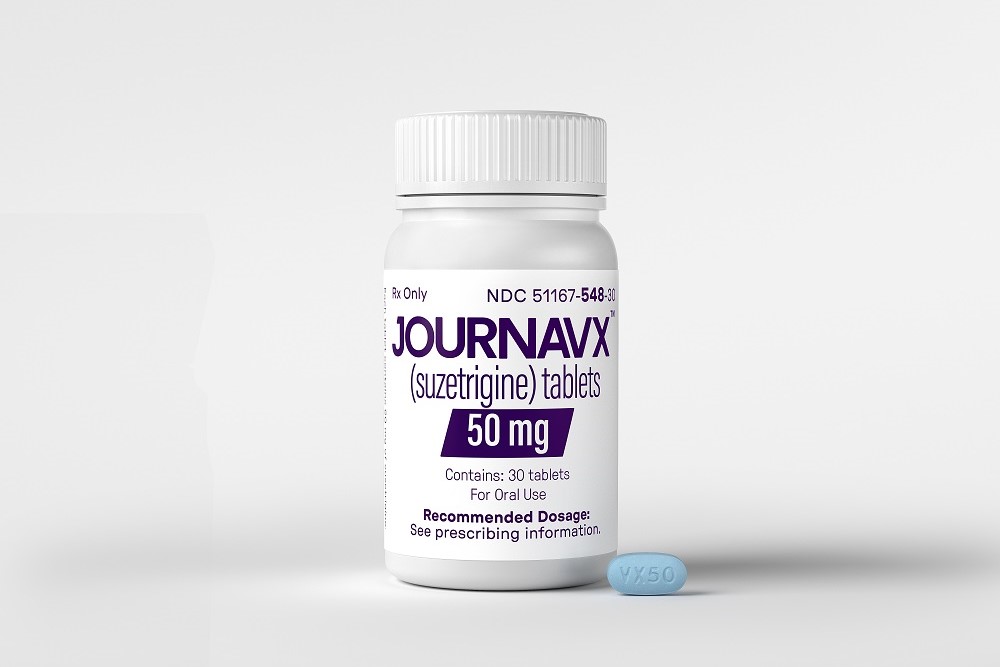
A novel Vertex Pharmaceuticals drug that takes a new approach to pain is now approved by the FDA, a landmark decision for a first-in-class product that brings patients a treatment alternative intended to avoid the addiction risks posed by opioid medications.
The regulatory decision announced late Thursday covers the treatment of moderate-to-severe acute pain in adults. Acute pain is defined as pain that lasts less than three months, such as aches following an injury or a surgical procedure. The Boston-based company’s new drug, a twice-daily pill known in development as suzetrigine, will be marketed under the brand name Journavx.
“Today’s approval is an important public health milestone in acute pain management,” Jacqueline Corrigan-Curay, acting director of the FDA’s Center for Drug Evaluation and Research, said in the agency’s approval announcement. “A new non-opioid analgesic therapeutic class for acute pain offers an opportunity to mitigate certain risks associated with using an opioid for pain and provides patients with another treatment option.”

Solera Health’s Playbook To Beat Rising Employer Expenses
Solera Health is working to streamline employer contracting with health tech.
The addiction risks of opioids come from their targeting of receptors in the central nervous system. But before pain signals reach the brain, they travel across pathways in the peripheral nervous system. Journavx targets one of these pathways, a sodium channel called NaV1.8. The drug is a small molecule designed to selectively block this channel without hitting other related sodium channels, which could lead to adverse effects. The drug comes from a pain research program that began at Vertex about 25 years ago.
FDA approval of Journavx is based on the results of two Phase 3 studies, one that tested the drug after abdominoplasty (tummy tuck) surgery and the other after bunionectomy surgery. Both studies met the main goal of showing statistically significant improvement compared to placebo according to a pain rating scale.
The studies also included as a comparator the drug Vicodin, an inexpensive painkiller that pairs the opioid hydrocodone with the main pharmaceutical ingredient in Tylenol. On this secondary trial measure, the results were disappointing. In tummy tuck patients, the numerical improvement achieved by suzetrigine fell short of statistical significance compared to Vicodin. In bunion surgery patients, Vicodin beat suzetrigine. The Vertex drug was safe and well tolerated in these studies. Vertex reported no addiction problems in the studies.
Vertex is also developing Journavx for chronic pain, but there have been mixed results so far. In a Phase 2 test in painful lumbosacral radiculopathy (lower back pain), data released last month showed that despite meeting the main goal according to a pain rating scale, the placebo arm posted a similar response. The study was not powered or designed to show differentiation from placebo, but Vertex’s stock price still took a hit. The company said it plans to advance the drug to a pivotal test in this indication, pending discussions with regulators. A Phase 3 test in painful diabetic peripheral neuropathy is ongoing. In a note sent to investors after the back pain trial readout, William Blair analyst Myles Minter said the lack of separation from placebo in that trial increases the risk for the ongoing Phase 3 diabetic peripheral neuropathy test.
Vertex set a $15.50 per pill price for Journavx. That’s slightly higher than the $12 per pill price that Leerink Partners modeled. A December report by the Institute for Clinical and Economic Review concluded that compared to treatment with Vicodin, the Vertex drug would lead to savings that mainly come from avoiding the excess healthcare costs associated with opioid use disorder.
A recent regulatory change should support reimbursement of the new Vertex product. The Non-Opioids Prevent Addiction in the Nation (NOPAIN) Act took effect on Jan. 1, requiring Medicare to provide separate reimbursement for qualifying non-opioid pain drugs. A goal of the legislation is to increase access to alternative pain drugs to reduce opioid use.
Leerink analyst David Risinger wrote in a research note that the Journavx label represents the best-case scenario for Vertex. There is no language for addiction or abuse potential, which Leerink expects will be critical to the drug’s utilization. The firm sees Journavx as the first in a series of novel non-opioid pain medicines coming from Vertex. Risinger said Leerink projects Journavx and follow-on NaV1.8 inhibitors for acute and neuropathic pain could top $10 billion in peak sales. That’s important for Vertex, which is working to diversify its portfolio beyond the cystic fibrosis products that currently bring in the vast majority of its revenue.
Photo by Vertex Pharmaceuticals








